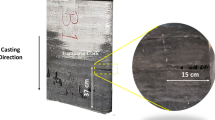Abstract
In situ scanning electron microscopy was performed during elevated-temperature (⩽760 °C) tensile-creep deformation of a face-centered-cubic cobalt-based Udimet 188 alloy to characterize the deformation evolution and, in particular, the grain boundary-cracking evolution. In situ electron backscatter diffraction observations combined with in situ secondary electron imaging indicated that general high-angle grain boundaries were more susceptible to cracking than low-angle grain boundaries and coincident site-lattice boundaries. The extent of general high-angle grain-boundary cracking increased with increasing creep time. Grain-boundary cracking was also observed throughout subsurface locations as observed for postdeformed samples. The electron backscattered diffraction orientation mapping performed during in situ tensile-creep deformation proved to be a powerful means for characterizing the surface deformation evolution and in particular for quantifying the types of grain boundaries that preferentially cracked.






Similar content being viewed by others
References
C.J. Lissenden, J.F. Colaiuta B.A. Lerch: Hardening behavior of three metallic alloys under combined stress at elevated temperature. Acta Mech. 169, 53 2004
D. Zhu, D.S. Fox R.A. Miller: Oxidation and creep-enhanced fatigue of Haynes 188 alloy-oxide scale system under simulated pulse detonation engine conditions. Ceram. Eng. Sci. Proc. 23.4, 547 2002
J. Chen, P.K. Liaw, Y.H. He, M.L. Benson, J.W. Blust, P.F. Browning, R.R. Seeley D.L. Karstom: Tensile hold low-cycle fatigue behavior of cobalt-based HAYNES® 188 superalloy. Scripta Mater. 44, 859 2001
J.D. Whittenberger: Mechanical properties of Haynes alloy 188 after exposure to LiF-22CaF2, air, and vacuum at 1093 K for periods up to 10,000 hours. J. Mater. Eng. Perf. 1, 469 1992
J.D. Whittenberger: Mechanical properties of Haynes alloy 188 after 22,500 hours of exposure to LiF-22CaF2 and vacuum at 1093 K. J. Mater. Eng. Perf. 3, 754 1994
R.B. Herchenroeder, S.J. Matthews, J.W. Tackett S.T. Wlodek: Haynes alloy No. 188. Cobalt 54, 3 1972
E.M. Lehockey G. Palumbo: On the creep behavior of grain boundary engineered nickel. Mater. Sci. Eng., A 237, 168 1997
V. Randle: The Role of Coincident Site Lattice in Grain Boundary Engineering The Institute of Materials London 1996 1–104
V. Randle: Refined approaches to the use of the coincidence site lattice. J. Met. 50, 2 56
E.M. Lehockey, G. Palumbo P. Lin: Improving the weldability and service performance of nickel- and iron-based suparalloys by grain boundary engineering. Metall. Mater. Trans. A 29, 3069 1998
B. Alexandreanu, B.M. Capell G. Was: Combined effect of special grain boundaries and grain boundary carbides on IGSCC. Mater. Sci. Eng., A 300, 94 2001
E.M. Lehockey, G. Palumbo, P. Lin A.M. Brennenstuhl: On the relationship between grain boundary character distribution and intergranular corrosion. Scripta Mater. 36(10), 1211 1997
C. Cheung, U. Erb G. Palumbo: Applications of grain boundary engineering concepts to alleviate intergranular cracking in alloys 600 and 690. Mater. Sci. Eng., A 185, 39 1994
G. Palumbo K.T. Aust: Special properties of Σ grain boundaries in Materials Interfaces: Atomic Level Structure and Properties, edited by D. Wolf and S. Yip (Chapman and Hall, New York) 1989 190–211
G. Palumbo, E.M. Lehockey P. Lin: Applications for grain boundary engineered materials. J. Met. 50(2), 40 1998
P. Lin, G. Palumbo, U. Erb K.T. Aust: Influence of grain boundary character distribution on sensitization and intergranular corrosion of alloy 600. Scripta Mater. 33(9), 1387 1995
G.S. Was, V. Thaveeprungsriporn D.C. Crawford: Grain boundary misorientation effects on creep and cracking in Ni-based alloys. J. Met. 50(2), 44 1998
V. Thaveeprungsriporn G. Was: The role of coincidence-site-lattice boundaries in creep of Ni-16Cr-9Fe at 36 °C. Metall. Mater. Trans. A 28, 2101 1997
G. Palumbo K.T. Aust: Structure-dependence of intergranular corrosion in high purity nickel. Acta Metall. Mater. 38(11), 2343 1990
C.J. Boehlert, C.J. Cowen, S. Tamirisakandala, D.J. McEldowney D.B. Miracle: In situ scanning electron microscopy observations of tensile deformation in a boron-modified Ti-6Al-4V alloy. Scripta Metall. 55, 465 2006
J.P. Quast C.J. Boehlert: Comparison of the microstructure, tensile, and creep behavior for Ti-24Al-17Nb-0.66Mo (at.%) and Ti-24Al-17Nb-2.3Mo (at.%) alloys. Metall. Mater. Trans. A 38, 529 2007
C.J. Cowen C.J. Boehlert: Comparison of the microstructure, tensile, and creep behavior for Ti-22Al-26Nb (at.%) and Ti-22Al-26Nb-5B (at.%). Metall. Mater. Trans. A 38, 26 2007
C.J. Boehlert: The effect of cold rolling on the creep behavior of Udimet alloy 188. World Sci. Eng. Acad. Soc. Trans. Heat Mass Transfer 1, 156 2006
T. Watanabe: An approach to grain-boundary design for strong and ductile polycrystals. Res. Mech. 11(1), 47 1984
Acknowledgments
This work was supported by the National Science Foundation through Grant DMR-0533954. The author is grateful to Mr. Nathan Eisinger (Special Metals Corporation, Huntington, WV) for overseeing the alloy processing, and to Mr. John Carpenter of EDAX-TSL, Inc. for his technical assistance.
Author information
Authors and Affiliations
Corresponding author
Rights and permissions
About this article
Cite this article
Boehlert, C., Longanbach, S., Nowell, M. et al. The evolution of grain-boundary cracking evaluated through in situ tensile-creep testing of Udimet alloy 188. Journal of Materials Research 23, 500–506 (2008). https://doi.org/10.1557/JMR.2008.0058
Received:
Accepted:
Published:
Issue Date:
DOI: https://doi.org/10.1557/JMR.2008.0058




